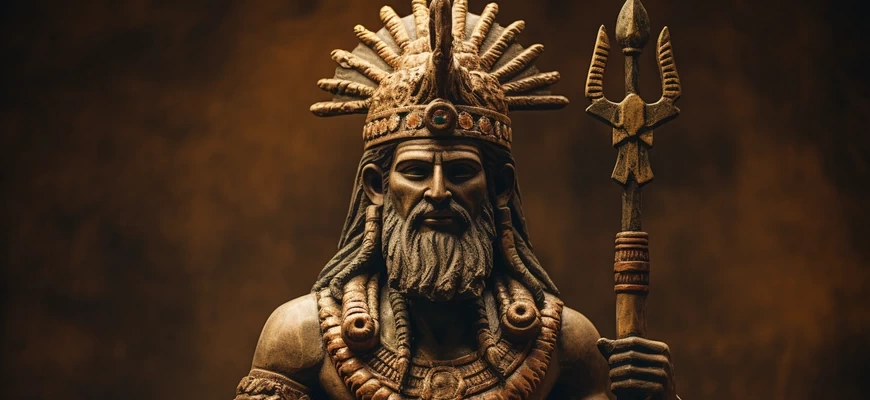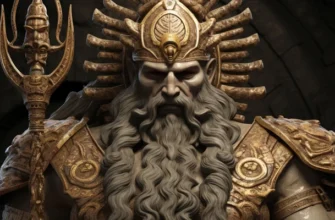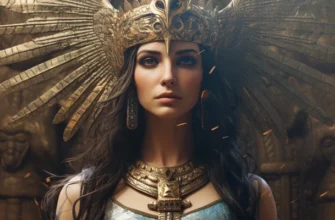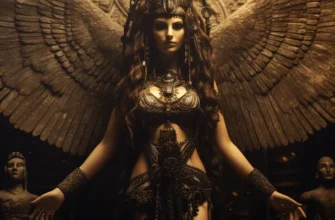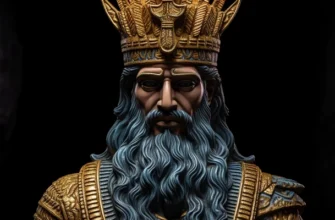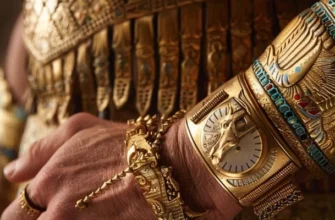The Sumerians worshiped the majestic god Anu, who possessed heavenly power and stood at the head of the divine hierarchy. His origin, symbolism, and worship reflected deep aspects of Sumerian mythology. Anu leaves a trace in archaeological finds, testifying to the importance of his cult in this ancient civilization.
The god Anu, in Sumerian mythology, is the ruler of the heavens and a key figure in the pantheon. His origins and genealogy, related to other deities, reveal information about Sumerian cosmogony. Anu’s role in the divine hierarchy determines his greatness and power over heaven and earth.
The origin of Anu
In Sumerian mythology, the god Anu emerged from the elements of chaos and an ancient divine family. His genealogy is linked to the mysteries of the beginning of the world, reflecting the unique nature of his divine birth process.
As a great Sumerian god, Anu interacted with other deities, establishing complex relationships in the pantheon. His kinship and alliance ties determined his role in the divine hierarchy, and also influenced the events and development of the mythology of ancient Sumer.
Role in the Pantheon
In the Sumerian pantheon, Anu played a key role as the ruler of heaven and earth. His superior status determined his function in the divine hierarchy, where he ruled over other gods and determined the course of cosmic events and human destiny.
Thus, in Sumerian mythology, Anu ruled over the other gods, acting as the ruler of the heavens and the head of the divine hierarchy. His power extended to both heaven and earth, determining his greatness and influence in the pantheon. As the father and grandfather of numerous other gods, he assumed the role of creating and governing the world, and his importance was emphasized in Sumerian texts and religious rites.
The god Anu played a key role in the pantheon of Sumerian mythology. The main aspects of his role include:
Lord of the heavens and the earth: Anu was the supreme ruler, dominating both the heavens and the earth. His cosmic power defined his unique position in the pantheon.
The head of the divine family: Anu was the father of numerous other gods, including Enlil and Ea. He acted as the patriarch of the divine family, weaving connections between the other members of the pantheon.
A symbol of cosmic order: His role in the pantheon was also defined as a symbol of order and stability in the cosmos. Anu’s power reflected the structure and harmony of the entire world.
Participation in mythological stories: Anu often appears in Sumerian myths, such as the Enuma Elish, which tell of the creation of the world and the struggle between the gods.
His position in the pantheon determined his role in the creation and governance of the world, and his influence was manifested in various aspects of Sumerian culture and religion.
The epic Enuma Elish and the role of Anu in it
“The Enuma Elish is an epic Sumerian-Akkadian text that tells the mythical story of the creation of the world and the struggle between the gods for power. The title “Enuma Elish” translates as “when the high heaven was named”. The text dates from around the 18th-17th century BC.
The content of the Enuma Elish: The poetic narrative begins with a description of the emergence of the world from chaos, where disorder and darkness reigned.
The god Apsu and the goddess Tiamat represent this chaos. They give rise to generations of gods.
The younger god Ea kills Apsu and then uses his body to create the world. Tiamat, outraged by the loss of her husband, starts a war against the gods.
The god Marduk, the son of Ea, comes to the fore, accepting a challenge from the other gods to fight Tiamat. Marduk defeats Tiamat, divides her body, and creates the world from it.
Marduk becomes a great ruler, and his majesty is honored by all the other gods. He establishes order in the world and endows the gods with his wisdom and power.
The role of the god Anu in Enuma Elish: Anu acts as the father of the god Marduk and grandfather to many other gods in the mythology.
In the Enuma Elish, his role in the beginning of the creation of the world is important, as this myth describes the formation of deities and the creation of the universe from chaos.
Symbolism and Worship
The symbolism of the god Anu included celestial attributes such as constellations and the sun. His worship included rites of grandeur and honor, in which worshippers expressed gratitude for the celestial grace and power that Anu held in the Sumerian pantheon.
The symbolism of the god Anu included celestial attributes such as constellations and the sun:
Constellations: Lord of the heavens: Anu acted as the ruler of the heavens, and the constellations symbolized his majesty and power over the cosmos.
A guide for people: The Sumerians used the constellations as a reference point for navigation and telling time, so constellation symbolism is also related to navigation and time division.
Sun: A source of light and heat: The sun in Anu symbolism reflected its role as a source of light and heat that brings life to the earth.
A symbol of divine power: Just as the sun is the brightest object in the sky, Anu was the most important god in the pantheon, possessing the highest divine power.
These symbols not only reflected important aspects of Anu’s cult, but also emphasized his role in the cosmic hierarchy and his power over the heavens and the earth.
How the Sumerians honored Anu
The Sumerians honored the god Anu through a variety of religious rites and ceremonies. The greatness and power of Anu was symbolized in ceremonies designed to express respect and blessings from the heavenly lord. Temples and shrines dedicated to Anu served as a place for communal worship and invocations to this majestic Sumerian god.
Sumerian texts about the god Anu
Sumerian texts dedicated to the god Anu are found in a variety of literary and religious sources. Some of them include:
Enuma Elish (Sumerian-Akkadian epic): This epic work tells the story of the creation of the world and the struggle between the gods for power. It also mentions the role of the god Anu in this cosmogonic process.
Religious texts with enumerations of gods: These contain lists of gods and their roles in the pantheon. Anu is often noted as the supreme god, the patriarch of a family of deities.
Prayers and ritual texts: Sumerian priests used prayers and ritual formulas to honor the god Anu and to express requests or thanks to him.
These texts provide a unique insight into the religious beliefs and cult of Anu in Sumerian society.
Shrines and temples dedicated to the god
The Sumerians built impressive temples and shrines dedicated to the god Anu. They were used for religious rites, sacrifices, and communal worship. These shrines served as a place for the faithful to come together and express their gratitude and worship before the majesty of this heavenly lord.
Unfortunately, details about the specific temples of the god Anu in Sumerian history are lost due to the passage of time and destruction. However, it is known that these temples were located in different parts of ancient Mesopotamia, and they served as centers of religious activity and worship. Archaeological excavations and research may reveal more information about these majestic structures and their role in Sumerian culture in the future.
Archaeological Finds
Archaeological finds related to the cult of the god Anu include ancient religious artifacts and written sources. Some of them are found in the ruins of ancient temples and shrines. Ritual objects, amulets, and images of the deity help to reveal details of the worship and rituals associated with the god Anu. This archaeological evidence plays an important role in understanding the religious and cultural aspects of Sumerian society.
Archaeological evidence for the existence of the Anu cult
There is archaeological evidence that confirms the existence of the cult of the god Anu in the Sumerian civilization. Religious artifacts, such as ceremonial objects, statuettes, and ritual vessels discovered during archaeological excavations, testify to the importance of this cult. Also, findings in the form of glyphs and inscriptions on tables and papyri provide additional information about the religious rites and worship associated with Anu. These materials are key sources for reconstructing the religious practices and cultural context associated with this deity in Sumerian society.
The cult of Anu in Sumerian mythology was manifested through religious rites, objects of worship, and shrines. The main aspects of the cult of Anu include:
Temples and Shrines: Shrines and temples dedicated to Anu served as places of religious rites and worship. They served as centers of worship and gatherings of believers.
Religious Rites: The annual and seasonal rites associated with Anu included prayers, rites of sacrifice, and other rituals that expressed respect and worship for this majestic god.
Prayers and Ritual Formulas:
Priests and worshippers used special prayers and ritual formulas to honor Anu, express blessings, and make requests to him.
Sacrifices: Various sacrificial rites were performed as part of the cult, which included animal and plant sacrifices to gain the god’s blessings and favor.
Symbolism and Images:Constellations and the sun acted as symbols of Anu, used in various images and artifacts that emphasized his cosmic power and divinity.
The cult of Anu profoundly influenced the religious and cultural aspects of Sumerian society, providing an important foundation for the beliefs and rituals of this ancient civilization.
Conclusion
The cult of the god Anu played a crucial role in shaping Sumerian culture. His power over the heavens and the earth determined the cosmogonic and religious ideas of the civilization. Archaeological findings indicate intensive religious practices and worship of this god. Modern research continues to uncover new aspects of the cult of Anu, expanding our understanding of Sumerian mythology and the influence of this cult on the formation of religious and cultural aspects of the ancient East.
